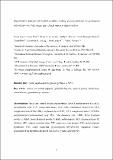Files in this item
Quantitative analysis of hydroxyapatite-binding plasma proteins in genotyped individuals with late-stage age-related macular degeneration
Item metadata
| dc.contributor.author | Arya, Swati | |
| dc.contributor.author | Emri, Eszter | |
| dc.contributor.author | Synowsky, Silvia A. | |
| dc.contributor.author | Shirran, Sally L. | |
| dc.contributor.author | Barzegar-Befroei, Neda | |
| dc.contributor.author | Peto, Tunde | |
| dc.contributor.author | Botting, Catherine H. | |
| dc.contributor.author | Lengyel, Imre | |
| dc.contributor.author | Stewart, Alan J. | |
| dc.date.accessioned | 2019-03-24T00:38:51Z | |
| dc.date.available | 2019-03-24T00:38:51Z | |
| dc.date.issued | 2018-07 | |
| dc.identifier | 252597345 | |
| dc.identifier | 06f0147d-e34d-44b1-80f5-9818ebabe00f | |
| dc.identifier | 85056278544 | |
| dc.identifier | 000436528900003 | |
| dc.identifier.citation | Arya , S , Emri , E , Synowsky , S A , Shirran , S L , Barzegar-Befroei , N , Peto , T , Botting , C H , Lengyel , I & Stewart , A J 2018 , ' Quantitative analysis of hydroxyapatite-binding plasma proteins in genotyped individuals with late-stage age-related macular degeneration ' , Experimental Eye Research , vol. 172 , pp. 21-29 . https://doi.org/10.1016/j.exer.2018.03.023 | en |
| dc.identifier.issn | 0014-4835 | |
| dc.identifier.other | ORCID: /0000-0003-3516-3507/work/43149681 | |
| dc.identifier.other | ORCID: /0000-0003-4580-1840/work/60195809 | |
| dc.identifier.other | ORCID: /0000-0001-7978-9507/work/61370157 | |
| dc.identifier.uri | https://hdl.handle.net/10023/17357 | |
| dc.description | We are also grateful to Fight for Sight for financial support (project grant to A.J.S and I.L.; grant ref.: 1586/1587). This research was also supported by “Eye-Risk” a European Union’s Horizon 2020 research and innovation program (grant ref.: 634479), Bill Brown Charitable Trust, MEH Special Trustees and Mercer Fund (I.L). This work was also supported by the Wellcome Trust (grant ref.: 094476/Z/10/Z) for funding the purchase of the TripleTOF 5600 mass spectrometer at the BSRC Mass Spectrometry and Proteomics Facility, University of St Andrews. | en |
| dc.description.abstract | Age-related macular degeneration (AMD) is associated with the formation of sub-retinal pigment epithelial (RPE) deposits that block circulatory exchange with the retina. The factors that contribute to deposit formation are not well understood. Recently, we identified the presence of spherular hydroxyapatite (HAP) structures within sub-RPE deposits to which several AMD-associated proteins were bound. This suggested that protein binding to HAP represents a potential mechanism for the retention of proteins in the sub-RPE space. Here we performed quantitative proteomics using Sequential Window Acquisition of all THeoretical fragment-ion spectra-Mass Spectrometry (SWATH-MS) on plasma samples from 23 patients with late-stage neovascular AMD following HAP-binding. Individuals were genotyped for the high risk CFH variant (T1277C) and binding to HAP was compared between wild type and risk variants. From a library of 242 HAP binding plasma proteins (1% false discovery rate), SWATH-MS revealed significant quantitative differences in the abundance of 32 HAP-binding proteins (p<0.05) between the two homozygous groups. The concentrations of six proteins (FHR1, FHR3, APOC4, C4A, C4B and PZP) in the HAP eluted fractions and whole plasma were further analysed using ELISA and their presence in sections from human cadaver eyes was examined using immunofluorescence. All six proteins were found to be present in the RPE/choroid interface, and four of these (FHR1, FHR3, APOC4 and PZP) were associated with spherules in sub-RPE space. This study provides qualitative and quantitative information relating to the degree by which plasma proteins may contribute to sub-RPE deposit formation through binding to HAP spherules and how genetic differences might contribute to deposit formation. | |
| dc.format.extent | 9 | |
| dc.format.extent | 2135776 | |
| dc.language.iso | eng | |
| dc.relation.ispartof | Experimental Eye Research | en |
| dc.subject | Drusen | en |
| dc.subject | Sub-retinal pigment epithelial deposits | en |
| dc.subject | Mineral-protein interactions | en |
| dc.subject | Retinal disease | en |
| dc.subject | Quantitative proteomics | en |
| dc.subject | QH426 Genetics | en |
| dc.subject | RC Internal medicine | en |
| dc.subject | DAS | en |
| dc.subject.lcc | QH426 | en |
| dc.subject.lcc | RC | en |
| dc.title | Quantitative analysis of hydroxyapatite-binding plasma proteins in genotyped individuals with late-stage age-related macular degeneration | en |
| dc.type | Journal article | en |
| dc.contributor.sponsor | The Wellcome Trust | en |
| dc.contributor.sponsor | Fight for Sight | en |
| dc.contributor.institution | University of St Andrews. School of Medicine | en |
| dc.contributor.institution | University of St Andrews. Cellular Medicine Division | en |
| dc.contributor.institution | University of St Andrews. School of Chemistry | en |
| dc.contributor.institution | University of St Andrews. School of Biology | en |
| dc.contributor.institution | University of St Andrews. EaSTCHEM | en |
| dc.contributor.institution | University of St Andrews. Biomedical Sciences Research Complex | en |
| dc.contributor.institution | University of St Andrews. Institute of Behavioural and Neural Sciences | en |
| dc.identifier.doi | https://doi.org/10.1016/j.exer.2018.03.023 | |
| dc.description.status | Peer reviewed | en |
| dc.date.embargoedUntil | 2019-03-24 | |
| dc.identifier.url | https://www.sciencedirect.com/science/article/pii/S0014483517307819#appd001 | en |
| dc.identifier.grantnumber | 094476/Z/10/Z | en |
| dc.identifier.grantnumber | 1586 / 1587 | en |
This item appears in the following Collection(s)
Items in the St Andrews Research Repository are protected by copyright, with all rights reserved, unless otherwise indicated.

